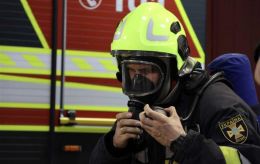Syrskyi's raids and new front: Battlefield shifts and Russia's readiness for summer
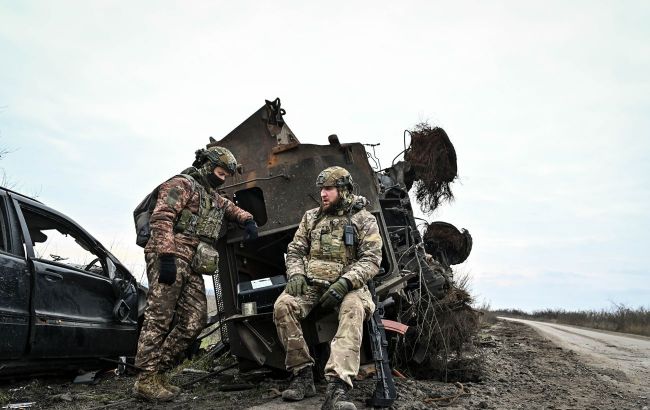 Ukrainian troops maintain defense in the east and south (Photo: Getty Images)
Ukrainian troops maintain defense in the east and south (Photo: Getty Images)
After the withdrawal of the Defense Forces from Avdiivka, the front line shifted westward. Command speaks of defense miscalculations and changes in leadership, while Russians have become more active in other areas and are preparing for a new offensive in May or early summer. The situation on the front, Russian plans, threats to Kyiv and Kharkiv, and what the Armed Forces need for a breakthrough are discussed in the review by RBC-Ukraine.
Sources used in preparation of the article: analysis from the Institute for the Study of War (ISW), maps from the DeepState project, statements from President Volodymyr Zelenskyy, Commander-in-Chief of the Armed Forces Oleksandr Syrskyi, military spokespersons, Financial Times articles, comments from experts Oleksandr Kovalenko and Vladyslav Seleznov.
Content
- How the front line changed after the withdrawal of the Ukrainian Armed Forces from Avdiivka
- Syrskyi at the front: Mistakes of brigade commanders and carte blanche for dismissals
- Kupiansk, Chasiv Yar, and beyond: Most dangerous frontlines
- Spring-summer 2024: What is known about Russia's plans, when and where will the new offensive happen
- Ukraine in defense: What is the situation with fortifications on the front line
- What the Armed Forces need for a breakthrough
How the front line changed after the withdrawal of the Ukrainian Armed Forces from Avdiivka
The situation around Avdiivka remains extremely challenging. In the past two weeks, the front line has shifted approximately 5 km westward, and the defense line has moved to the Berdychi-Orlivka-Tonenke line. Last week, the occupiers broke through the outskirts of Orlivka but were repelled by the forces of the 3rd Separate Assault Brigade and the 25th Separate Airborne Brigade.
Assaults continue in the areas of Berdychi, Tonenke, Pervomaiske, and Nevelske. The enemy is increasing the intensity of artillery fire and deploying reserves, thus achieving local successes. Ukrainian forces are actively defending and, where possible, reclaiming control of positions, establishing fire points, and observation posts.
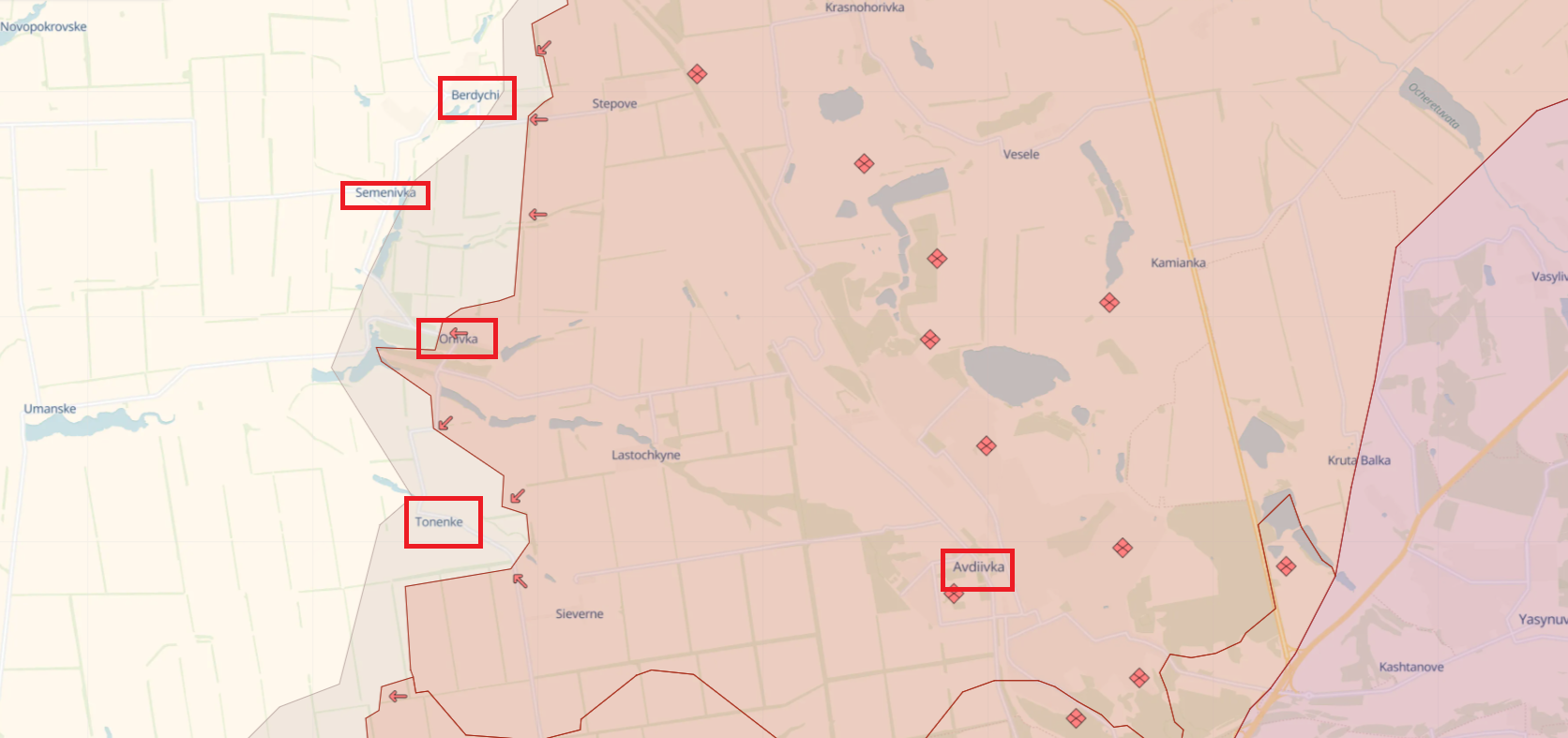 Photo: The Russians are attempting to establish a security buffer for their grouping in Avdiivka, the Ukrainian defense line now stretches from Berdychi to Tonenke (deepstatemap.live)
Photo: The Russians are attempting to establish a security buffer for their grouping in Avdiivka, the Ukrainian defense line now stretches from Berdychi to Tonenke (deepstatemap.live)
To the west of Avdiivka, the Russians are attempting to establish a security buffer for their grouping, which will be located in the city. It roughly follows a semicircle through the villages where fighting is taking place. The first line was supposed to pass through Stepove, Lastochkyne, and Sieverne, but they were relatively quickly captured, explains military and political expert of the Information Resistance Group Oleksandr Kovalenko.
"The broader circle includes Berdychi, Semenivka, Orlivka, and Tonenke. This is where they are trying to gain a foothold, and this is their main goal," he says in a comment to RBC-Ukraine.
Recently, the spokesman for the Tavria operational-strategic group, Dmytro Lykhoviy, stated that the situation was being stabilized. According to him, the enemy's advance has been halted in the villages, as the occupiers have partially entered and controlled Berdychi and Tonenke. As analysts from DeepState note, the Russians are accumulating forces to try to exploit their success.
Military journalist and former chief of the press service for the General Staff of Ukraine, Vladyslav Seleznov, believes that the Defense Forces have managed to secure themselves on the Berdychi-Tonenke line, and there probably won't be a breakthrough here soon. Especially considering the words of the Chief of Military Intelligence Kyrylo Budanov about the fact that the offensive potential of Putin's army will be exhausted in the first half of March.
"Most likely, an operational pause is already occurring. The enemy is still trying to attack, but since statements about stabilizing the front are being made, we have probably entrenched ourselves on the prepared lines to the west of Avdiivka. Moreover, in the last couple of days, I've been hearing signals that the Ukrainian artillery is operating at a faster pace and in larger volumes. This means we have artillery and ammunition," he emphasizes.
Syrskyi at the front: Mistakes of brigade commanders and carte blanche for dismissals
After being appointed as the Commander-in-Chief of the Armed Forces of Ukraine, Oleksandr Syrskyi took on the audit of the Defense Forces. He intends to visit each brigade and draw conclusions regarding reserves and rotations, as well as identify weaknesses, ascertain the number of mobilized personnel, and what percentage of them are on the front lines. As part of the audit, he headed to the Donetsk group's area of responsibility and stated that some commanders had made mistakes that had somehow affected the defense.
"I have taken all measures to rectify the situation on the ground, allocating additional resources of ammunition and material means, as well as necessary reserves," he noted.
He also set three tasks: to inflict maximum losses on the Russian Federation by destroying artillery and armored vehicles, to hold the occupied positions, and to regain control over those that were lost. Within three days in the east, Syrskyi understood why, despite having the same level of personnel, weapons, and equipment, some brigades manage to repel attacks while others do not. According to him, in certain cases, brigade commanders did not grasp the situation, and their teams posed threats to the lives of subordinates, so personnel decisions had to be made.
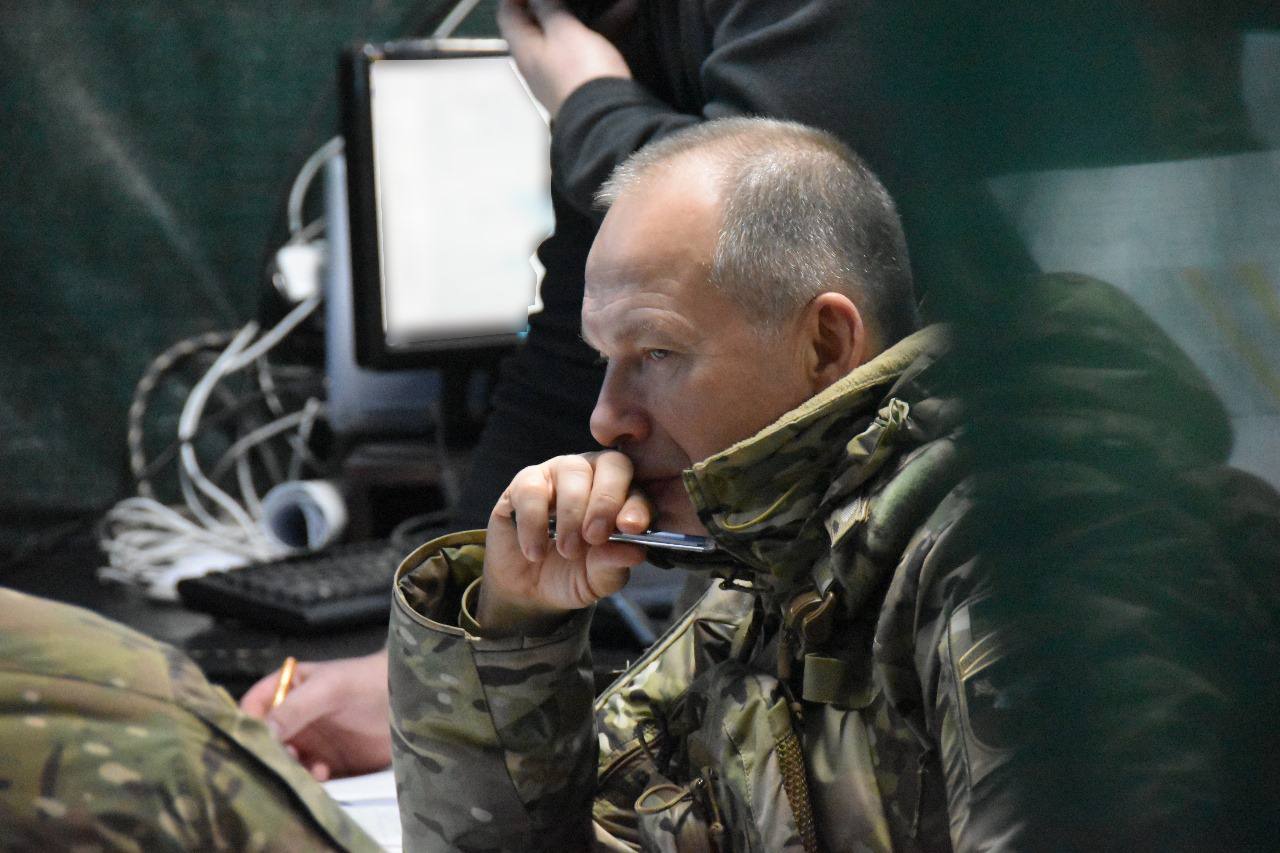 Photo: Oleksandr Syrskyi is dissatisfied with some brigade commanders (t.me/osirskiy)
Photo: Oleksandr Syrskyi is dissatisfied with some brigade commanders (t.me/osirskiy)
As explained by President Volodymyr Zelenskyy, Syrskyi has carte blanche for reshuffles in the army and staff.
"All Ukrainian commanders must know the front, feel the front, and understand the real needs. We must be with the soldiers, the sergeants," he added.
It should be noted that the fate of both individual soldiers and entire units depends on commanders in field conditions.
"If a person in office cannot effectively manage personnel, adequately assess the state of their forces and resources, and the combat capabilities of the enemy army, they have no business in that position. I do not know if there were specific personnel decisions after Syrskyi's statement, but if so, it's good news. Just recently, I saw the results of surveys, and the key concern of citizens who fear mobilization concerns precisely ineffective commanders who do not value human life," Seleznov notes.
Kupiansk, Chasiv Yar, and beyond: Most dangerous frontlines
For the first time, the Russians managed to enter Krasnohorivka – the last city in the Donetsk agglomeration under Ukrainian control. This settlement is located to the north of the captured Maryinka. The enemy, using armored vehicles, broke through minefields, and to push them out of Krasnohorivka, the 3rd Separate Assault Brigade was engaged.
It was reported that the Russian army attacked the southeastern part with onslaughts and entered the city. However, with the efforts of two battalions, the clearance was successful. As indicated by the brigade, the Russians refused to surrender and were "eliminated in the occupied buildings." The losses were estimated at about 100 liquidated and wounded occupiers.
A little further south, the enemy is advancing on Novomykhailivka. The Institute for the Study of War (ISW), referring to geolocated footage, reports on the advance of marines to the central part of the village. Tavria spokesperson Dmytro Lykhoviy emphasizes that there are more enemy assaults here than near Avdiivka. However, the defense holds, and despite the huge efforts made by the enemy, they have not succeeded "at all."
Chasiv Yar remains another hot spot. Russian forces are gradually advancing towards the city, with the main thrust concentrated on the villages of Bohdanivka and Ivanivske. Judging by DeepState maps, half of Ivanivske is already under the control of the occupiers. The spokesperson of the Khortytsia operational-strategic group, Illia Yevlash, calls the actions of the Russian Federation a powerful breakthrough: the enemy advances on a wide front and, as soon as they find weak spots in the Ukrainian defense, they deploy reserves there to widen the breakthrough.
"Access to Chasiv Yar will open the enemy the way for further offensive actions, a foothold for advancing on Kostiantynivka," he explained, adding that the main goal of the enemy in Donetsk is the Kramatorsk-Sloviansk agglomeration.
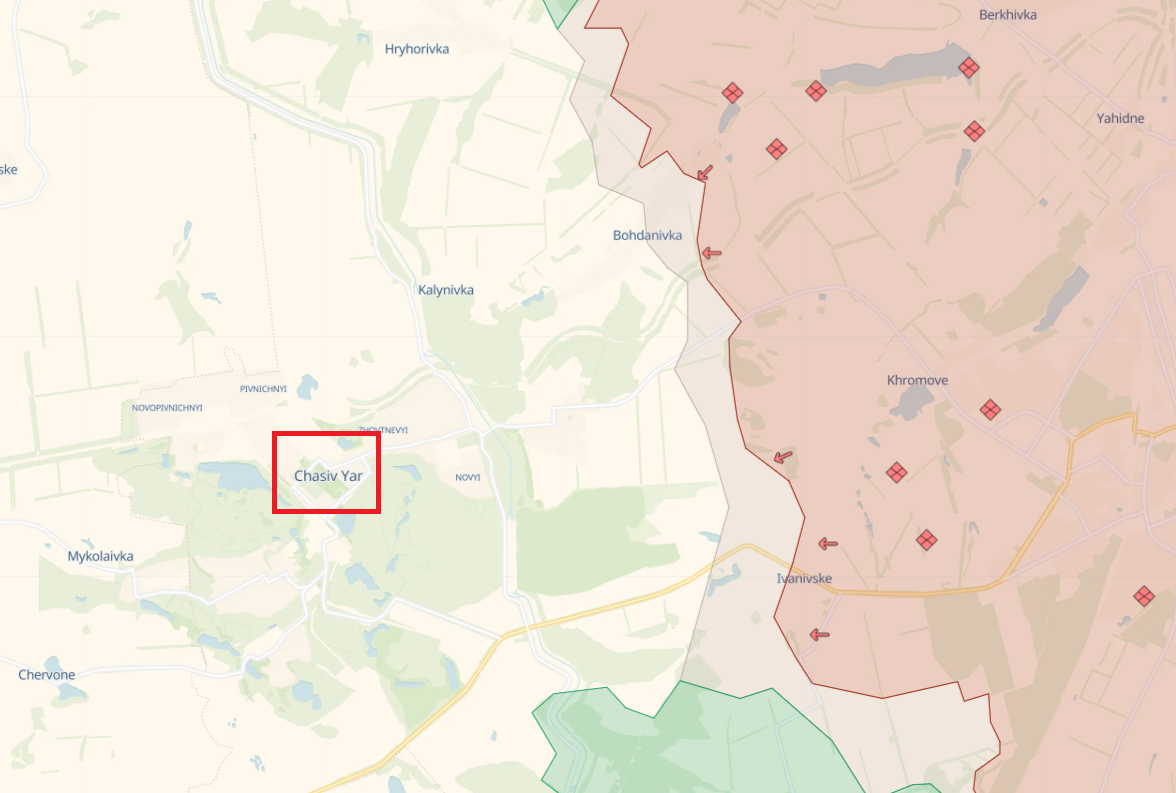
Photo: Chasiv Yar remains one of the priority directions of the Russian attack (deepstatemap.live)
Near Kupiansk, Ukrainian forces have achieved local successes near Tabaivka. As stated by the head of the Kharkiv Regional State Administration, Oleh Syniehubov, our troops are trying to push the enemy out of the heights. To the east of the occupied Kreminna, battles are raging near Yamopolivka and Terniv, but overall, enemy activity in the Lyman direction has significantly decreased.
There are no changes on the southern front. On the Berdiansk stretch, there were attempts by the occupiers to advance near Novodonetske and Pryiutne. In the Zaporizhzhia region, they are maintaining activity in the area of Robotyne and Verbove, and on the left bank of the Kherson region, they are not giving up hope of pushing Ukrainian defenders out of Krynky. As the spokesperson for the Defense Forces of the South of Ukraine, Natalia Humeniuk, said, the village has practically been leveled, our fighters have no intention of retreating, and the Russians are conserving their armored vehicles, so they currently have "season of сannon fodder assaults."
Oleksandr Kovalenko highlights several dangerous directions.
"According to Plan No. 1, these are Kupiansk and Chasiv Yar. For them, these are the main vectors of the offensive. Not even Lyman, and not even as much Bilohorivka (Luhansk region, - Ed.), although there is very high pressure there as well. But Kupiansk and Chasiv Yar are quite large settlements and fortified enough to say that they will achieve situational success in the near future," the expert says.
In addition, there is a significant threat to the village of Novomykhailivka to the southwest of Donetsk.
"It is important for the occupiers to establish control along Highway 0532, and Novomykhailivka remains one of the obstacles. Its capture is necessary to essentially close the issue with Vuhledar," he says in an interview with RBC-Ukraine.
According to him, the fourth dangerous direction is the Zaporizhzhia region, namely the Robotyne bulge. The expert believes that the enemy will continue to press on Robotyne to regain control of the bulge, which the Defense Forces recaptured in the summer of 2023.
"Only in this way can they level the line of the battle. Currently, this gap in the line is unpleasantly hanging, forcing the Russians to be nervous," he adds.
Spring-summer 2024: What is known about Russia's plans, when and where will the new offensive happen
The coming months will evidently be challenging for Ukraine. President Volodymyr Zelenskyy made such a statement, citing hesitancy in the United States, which influences other Western partners as well.
"It will be difficult for us in March-April, we will go through such a period of waves, both political and financial, of various pressures. Russia will prepare for an offensive at the beginning of summer or at the end of May," he said, without specifying where exactly Russia will advance.
 Photo: Volodymyr Zelenskyy states that Russia is preparing for a new offensive in May or at the beginning of summer (Vitalii Nosach / RBC-Ukraine)
Photo: Volodymyr Zelenskyy states that Russia is preparing for a new offensive in May or at the beginning of summer (Vitalii Nosach / RBC-Ukraine)
Kovalenko rules out the possibility of an advance on Kyiv or Kharkiv. According to him, the maximum the enemy can do is to intensify operations in areas where fighting has been ongoing for some time. He believes the enemy simply does not have the resources for new directions. As for the scale, one should not expect a particularly large offensive. And it is unlikely to start before summer, as, after Putin's March elections, time will be needed for mobilization.
Vladyslav Seleznov sees no threat to the northern regions. And suggests evaluating threats based on the number of Russian groupings, for example, the one near Avdiivka remains quite strong – about 80,000 people, and on the Lyman-Kupyansk axis – about 110,000.
"If you think logically, Putin dreams of physical control over territories he calls 'new regions.' Considering that he lacks resources to cross the Dnipro in the south, and the situation in the Zaporizhzhia region has stabilized, most likely, the summer offensive will focus on capturing Donetsk region," he tells the new agency.
According to him, to fully occupy the four regions, the Russians need to at least double the number of occupation forces from the current 460,000.
"It is difficult to predict whether Putin will be able to implement this plan, whether he will have enough resources – this is an open question. I hope by that time Western partners will come to their senses and start providing us with weapons and equipment in quantities that will allow us to at least have parity on the battlefield. And if our statements about powerful defense lines do not match the real steps, then without a multiple increase in personnel, the Russians definitely won't have enough forces for the 'mission of the four regions,'" the expert adds.
Ukraine in defense: What is the situation with fortifications on the front line
The future Russian offensive is expected to encounter Ukrainian engineering fortifications. Prime Minister Denys Shmyhal stated that 20 billion hryvnias have been allocated for this purpose since the beginning of 2024, with an additional nearly 11 billion available. The largest allocations went to the Kharkiv (4 billion) and Sumy (1.8 billion) regions, with the rest distributed among the frontline areas, as well as the Volyn, Odesa, and Kyiv regions, ranging from 1.1 to 1.5 billion hryvnias.
Discussions about defense lines intensified in late fall when it became clear that the counteroffensive in 2023 did not achieve its goals and the initiative shifted to Russia. President Zelenskyy demanded an acceleration of construction along the entire front, emphasizing that the state has enough "mines and concrete."
 Photo: Ukrainian defense lines (facebook.com/KSP.ZSU)
Photo: Ukrainian defense lines (facebook.com/KSP.ZSU)
According to the Command of the Support Forces of the Armed Forces of Ukraine, fortifications are being built around the clock. It was reported in February that Defense Minister Rustem Umerov and Commander Syrskyi would personally oversee these efforts, citing the work done near Kupiansk as an example.
"As far as I know, in the Kupiansk direction, specifically in Khortytsia, we have done all this at a very high level and this serves as an example for other directions," said Zelenskyy.
The exact location of the defensive lines and how powerful they are is understandably unknown. In a classic execution, they are built in three lines at varying distances from the front. The first line is a support zone with minefields, trenches, secret positions with anti-tank-guided missile systems, and machine gun points. The second line is the main line with motorized infantry units, tanks, and artillery. The third line is the rear area, primarily consisting of ammunition depots, headquarters, command posts, etc.
More about this can be found in a separate material by RBC-Ukraine.
As spokesman for the Tavria group, Dmytro Lykhoviy, explained, the fortifications consist of a network of backup positions, trenches hundreds of meters long with firing points, tank caponiers, anti-tank ditches, and so on.
"Of course, there can never be enough fortifications. Everyone wants more of them. But it should be understood that it cannot be a wall like in "Game of Thrones," he said, referring to a wall from the popular series that protected the world of the living from the world of the dead.
RBC-Ukraine's interlocutors note that they could not assess the built fortifications. However, they assume that since work is constantly being done on all fronts, the situation has improved compared to three months ago.
"I proceed from the following considerations. Where we managed to stabilize the front, there are fortifications. Where we are forced to maneuver and retreat, accordingly, there are no fortifications, despite the statements of official spokesmen. For example, in the Kupiansk direction, the enemy could not do anything with our lines, but we lost Lastochkyne (near Avdiivka). Therefore, we rely on the front line. If it moves, then we have serious problems with fortifications," explains Seleznov.
What the Armed Forces need for a breakthrough
The prospects for a significant breakthrough of the front line in 2024 are small, for both sides. Ukrainian leadership has announced a strategy of active defense: wearing down the enemy, identifying weak points, and striking. It is anticipated that this tactic will allow for buying time, building strength, and preparing for an offensive in 2025.
"The current year 2024 is not about our offensive. It's about strategic defense and accumulating resources for the future," notes Seleznov.
For a Ukrainian breakthrough, what former Commander-in-Chief of the Armed Forces of Ukraine Valerii Zaluzhnyi wrote about is necessary. This includes precision and long-range artillery, missiles, armored vehicles, demining equipment, electronic warfare systems, drone systems, reliable communication, and verified intelligence. Individual elements alone cannot ensure a breakthrough. Miracle weapons don't exist; even F-16 fighters or long-range ATACMS missiles won't fundamentally change the situation. Success on the battlefield will only be achieved through the combination, synchronization, and simultaneous use of all these elements.
 Photo: Only technological superiority, which depends on Western partners, will ensure a breakthrough for Ukraine (Getty Images)
Photo: Only technological superiority, which depends on Western partners, will ensure a breakthrough for Ukraine (Getty Images)
Oleksandr Kovalenko refers to all this as a "technological breakthrough."
"We need not only ammunition, which everyone talks about. We also need aviation, a wide range of missiles, from long-range ATACMS and Taurus to AGM-158 JASSM missiles for F-16 aircraft, and so on. Tanks, armored vehicles, electronic warfare complexes – everything needed for combat operations. And most importantly, technological superiority. Currently, we are in a situation where only the side that achieves a technological breakthrough can turn the tide of war. Russia will not achieve this; it doesn't have such capability. But Ukraine's partners have the necessary resources, so it all depends on them," he says in a comment to RBC-Ukraine.
However, walls cannot defend themselves, and one of the factors is trained and motivated personnel. It suggests that without intensified mobilization, a breakthrough is impossible. However, before that, an information campaign needs to be conducted, according to Vladyslav Seleznov.
"The current situation, in my opinion, is the result of nobody dealing with the issue properly. As a result, society initially created the illusion that soldiers would solve the issue without us. After that didn't happen, fears arose, which were not quickly dispelled. Including fears about the adequacy of commanders, training, and provision. I don't see a systematic explanatory campaign. Instead, we often hear scare stories, like it's better to die near Avdiivka than work as a barista in Romania. This is clearly not the motivation that encourages Ukrainians to take up arms," adds the expert.
